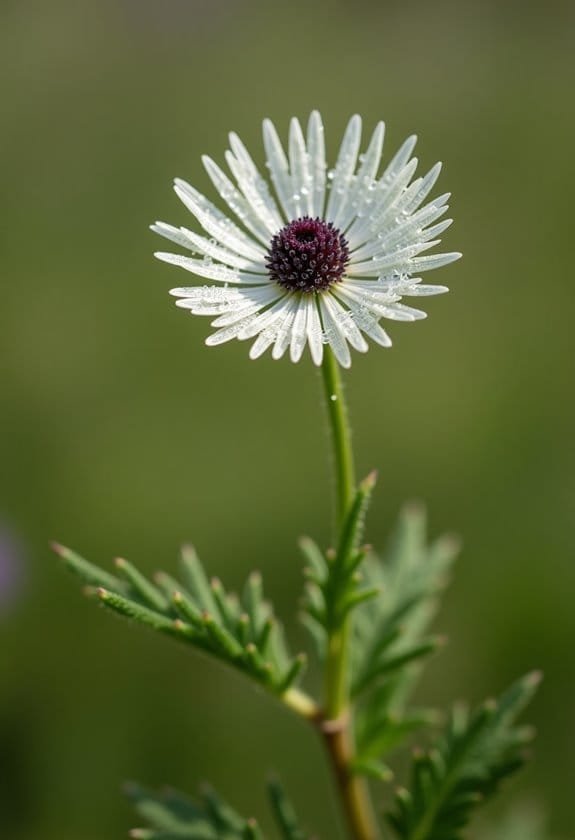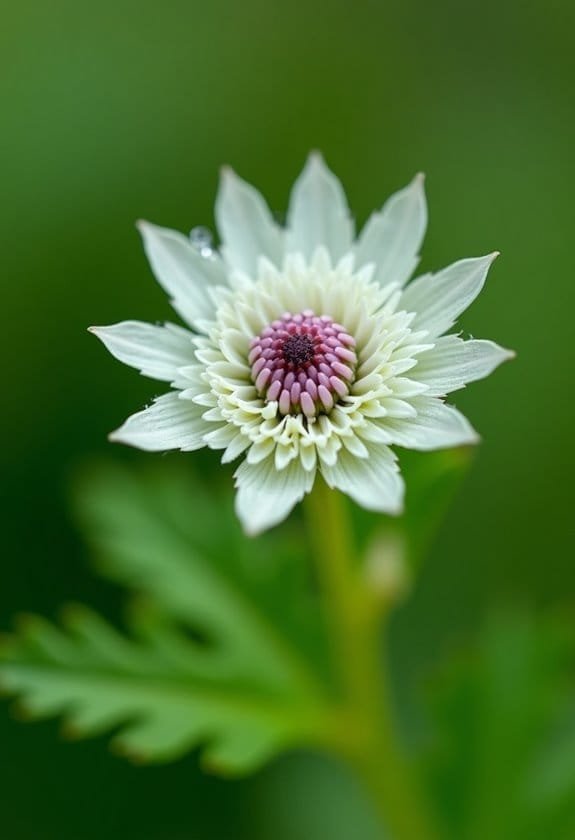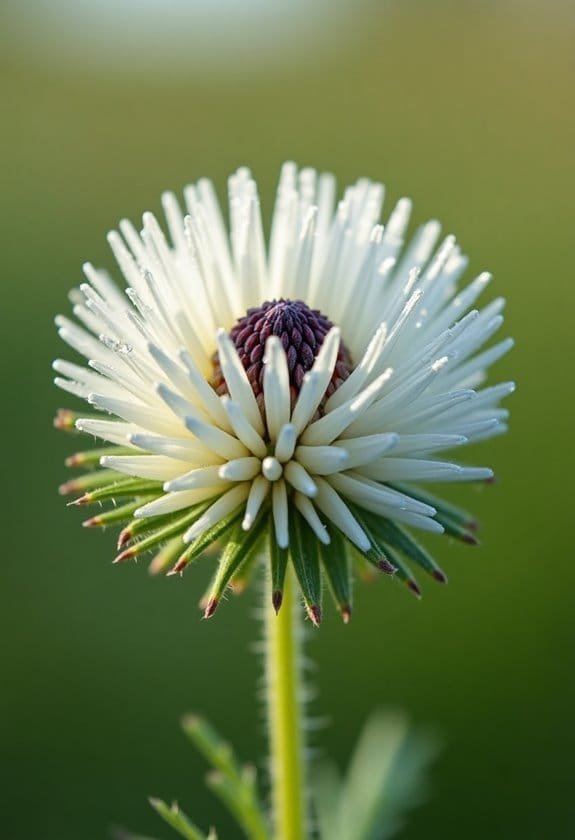Wild carrot (Daucus carota), also known as Queen Anne's lace, is a fascinating member of the Apiaceae family that's widely distributed across Europe and southwest Asia. This hardy plant grows 30-150 cm tall, featuring distinctive umbrella-shaped white flower clusters with a central dark floret that cleverly mimics insects to attract pollinators. It's characterized by finely divided tripinnate leaves, bristly stems, and a carrot-like fragrance when disturbed. While its young roots are edible, careful identification is essential to avoid confusion with toxic lookalikes, especially poison hemlock. The plant's remarkable ecological role and genetic heritage hold many more surprises.
Main Points
- Wild carrot (Daucus carota) is a flowering plant with finely divided leaves and umbrella-shaped white flower clusters featuring a dark central floret.
- The plant grows 30-150 cm tall and produces 1,000-40,000 seeds per plant, spreading easily through wind and animal dispersal.
- It serves as a crucial host plant for eastern black swallowtail butterflies and supports various pollinators in meadows and grasslands.
- Wild carrot has edible young roots but requires careful identification to avoid confusion with toxic poison hemlock, which can be lethal.
- The plant prefers well-drained soils, moderate temperatures between 15-24°C, and blooms from June through September.
Introduction

The wild carrot (*Daucus carota*), a remarkable biennial herb belonging to the Apiaceae family, stands as the ancestral predecessor to our modern cultivated carrot.
Growing impressively from 30 to 150 centimeters in height, this versatile plant showcases delicate white flowers arranged in distinctive umbrella-shaped clusters called umbels.
Found naturally across Europe and southwest Asia, the wild carrot has successfully spread to North America and Australia, where it thrives in meadows, grasslands, and along roadsides, earning its reputation as both a resilient pioneer species and a valuable traditional food source.
Common Name
Known widely as Queen Anne's lace, wild carrot (Daucus carota) earned its elegant nickname from its delicate white flower clusters that resemble the intricate lacework popular during Queen Anne of Britain's reign.
This enchanting plant has captivated botanists and nature enthusiasts alike with its striking floral displays, which appear from June through September during its second year of growth.
While Queen Anne's lace remains the most widely recognized common name for this species, particularly in North America and Britain, the plant also goes by several other identifiers.
European wild carrot serves as another frequent designation, highlighting the plant's continental origins and its relationship to modern cultivated carrots.
The straightforward name "wild carrot" directly references its natural, uncultivated state and its membership in the Apiaceae family, which encompasses familiar culinary herbs like parsley and coriander.
This nomenclature connection becomes particularly apparent when the plant's taproot is disturbed, releasing a distinctive carrot-like fragrance that, while less prominent than its cultivated cousins, unmistakably reveals its botanical heritage.
Scientific Name
According to botanical nomenclature, *Daucus carota* stands as wild carrot's scientific designation, first documented by Swedish botanist Carl Linnaeus in his groundbreaking 1753 work *Species Plantarum*. This classification places the plant firmly within the Apiaceae family, alongside its aromatic relatives like coriander and parsley.
The species comprises two primary subspecies that reflect its evolutionary journey: *Daucus carota* subsp. sativus, representing the cultivated variety, and *Daucus carota* subsp. carota, denoting its wild ancestor.
Modern scientific understanding of this species has expanded considerably, particularly following the thorough genome sequencing completed in 2016 by an international research consortium.
The taxonomic significance of *Daucus carota* extends beyond mere classification, as its widespread distribution and remarkable adaptability have earned it a "Least Concern" status from the International Union for Conservation of Nature.
This scientific designation serves as a foundation for understanding the plant's relationship to other species, its genetic heritage, and its role in both natural ecosystems and agricultural systems worldwide.
Overview
Among flowering plants of temperate regions, wild carrot (*Daucus carota*) stands out as a resilient biennial herb that's played a significant role in both natural ecosystems and human cultivation.
Often referred to as Queen Anne's Lace due to its delicate, lace-like flower clusters, this remarkable plant typically reaches heights between 30 to 120 centimeters, adorning roadsides and meadows with its distinctive presence.
The plant's most striking feature is its umbrella-shaped flower head, which showcases numerous tiny white blooms arranged in intricate patterns, with a singular dark floret at the center serving as a beacon for pollinators.
Wild carrot demonstrates remarkable reproductive efficiency, with individual plants capable of generating up to 40,000 seeds that disperse effectively through wind and animal movement.
While the plant offers edible components, including young roots and seeds, proper identification is essential, as it bears a close resemblance to the lethal poison hemlock.
Originally native to Europe and southwest Asia, wild carrot has successfully naturalized across North America and Australia, proof of its remarkable adaptability and survival strategies.
Key Features
The wild carrot stands as a striking biennial herb, reaching heights between 30 to 120 centimeters with distinctive stiff, hairy stems and finely divided tripinnate leaves.
Its most notable features include the delicate white flowers that form umbrella-like clusters called umbels, measuring 8 to 15 centimeters across, which grace the landscape from June through September.
A fascinating characteristic of these flower clusters is their dark central floret, which mimics insects to attract pollinators, while the entire plant releases a characteristic carrot-like fragrance from its foliage.
Growth Size
Wild carrot presents distinctive growth characteristics, reaching heights between 30 to 120 cm (1 to 4 ft) with a sturdy, bristly stem. This remarkable growth size enables the plant to establish a commanding presence in its natural habitat, while its solid stem provides essential structural support for the extensive flowering system above.
The plant's impressive vertical development is complemented by its horizontal spread, featuring intricate tripinnate leaves that extend 5-15 cm in length. These triangular leaves create a substantial foliar display that enhances the plant's overall stature.
The terminal umbels, spanning 8-15 cm in width, crown the plant's vertical growth with clusters of delicate white flowers that bloom throughout the summer months.
The wild carrot's growth dimensions serve multiple ecological functions, positioning its flowers at an ideal height for pollinator access while allowing effective seed dispersal.
The plant's substantial size also facilitates the production of its numerous seeds, with individual specimens capable of generating between 1,000 to 40,000 seeds, ensuring successful reproduction and population stability in various environmental conditions.
Appearance
Distinct from other members of its family, wild carrot showcases several unmistakable features that make it easily identifiable in natural settings. The plant's stiff, solid stems exhibit a somewhat hairy texture, rising prominently to heights between 30 and 120 centimeters, creating a robust architectural presence in fields and meadows.
The plant's appearance is further distinguished by its intricately divided leaves, which form triangular shapes measuring 5 to 15 centimeters in length. These tripinnate leaves release a characteristic carrot-like fragrance when disturbed, adding to the plant's sensory identity.
Perhaps most striking are the flowers, which arrange themselves in elegant terminal umbels spanning 8 to 15 centimeters across. These dull white blooms cluster together from June through September, featuring a fascinating dark central floret that serves as a clever insect mimic to attract pollinators.
The plant's fruits present another distinctive characteristic, appearing as small, flattened ovals adorned with hooked spines and protective hairs, an adaptation that guarantees successful seed dispersal through attachment to passing animals or clothing.
Flowering Season
During peak summer months, wild carrot's remarkable flowering period transforms landscapes into enchanting displays of white umbels. From June through September, these hardy plants produce an abundance of small white flowers that cluster together in distinctive flat-topped formations spanning 8 to 15 centimeters across.
The flowering stems reach impressive heights between 30 and 120 centimeters, creating a striking vertical presence in meadows and fields. At the center of each umbel lies a peculiar dark floret, which serves as a clever mimicry of insects to attract potential pollinators.
As the season progresses, these flowering heads undergo a fascinating metamorphosis, curling inward to form structures resembling bird nests, which aids in the dispersal of their prolific seed production.
The plant's reproductive strategy is particularly efficient, with each specimen capable of generating between 1,000 and 40,000 seeds. Throughout their blooming period, these flowers play a crucial role in supporting local ecosystems, attracting diverse beneficial insects that contribute to pollination networks and broader biodiversity maintenance within their habitats.
Growing Requirements

Wild carrot demonstrates remarkable adaptability in its growing requirements, flourishing in full sun to partial shade across various soil conditions.
The plant's successful establishment depends on well-drained soils, whether sandy or clay-based, with its deep taproot system allowing it to thrive even in less fertile environments.
While wild carrot tolerates a broad temperature range, it shows ideal growth in temperate climates where consistent moisture supports its biennial life cycle of vegetative growth followed by flowering.
Light
Throughout the growing season, light plays a vital role in the development of wild carrot plants. These adaptable organisms require a minimum of six hours of direct sunlight daily to achieve ideal growth and maintain their characteristic vigor. While they can tolerate partial shade, full sun exposure provides the most favorable conditions for robust development and successful reproduction.
The plant's relationship with light becomes particularly significant during its biennial flowering cycle, as adequate sunlight directly influences both flowering intensity and seed production.
In environments where light levels fall below ideal requirements, wild carrots often display notable adaptations and potential limitations. Plants growing in shadier locations typically exhibit slower growth patterns and may produce fewer flowers, which ultimately affects their reproductive capabilities and population sustainability.
The impact of light availability extends beyond mere survival, as it interacts with other environmental factors such as soil drainage and moisture retention to create a complex web of growing conditions.
For wild carrots to thrive and complete their life cycle successfully, maintaining proper light exposure remains paramount, particularly in cultivated or managed settings.
Soil
Most wild carrot populations thrive in well-drained soils, displaying remarkable adaptability across various soil compositions from sandy to clay-based substrates. Their resilient nature enables them to establish themselves in diverse soil conditions, though they show a particular affinity for alkaline environments where they achieve peak growth and development.
These hardy plants demonstrate a strong preference for disturbed soils where competition from other vegetation is minimal, making them efficient colonizers of newly exposed or disrupted terrains.
The plant's relationship with soil extends beyond mere sustenance, as its characteristic deep taproot system plays an important role in soil stabilization and structural enhancement. This natural engineering capability makes wild carrot an invaluable contributor to garden ecosystem health, while its moisture requirements strike a careful balance between adequate drainage and hydration.
The plant's ability to flourish in various soil conditions is further complemented by its tolerance of different light exposures, though it's crucial to avoid waterlogged conditions that could compromise root development and overall plant vigor.
Water
During their growth cycle, Daucus carota maintains specific water requirements that balance drought tolerance with the need for consistent moisture. The plant's sophisticated root system enables it to adapt to varying moisture levels, though excessive water can prove detrimental to its development and survival.
Young wild carrot seedlings require regular watering to establish strong root networks, which form the foundation for their future drought resilience. As the plants mature, their water needs become less demanding, and they demonstrate remarkable adaptability to drier conditions while maintaining healthy growth patterns.
The key to successful wild carrot cultivation lies in maintaining moderate soil moisture levels that prevent both waterlogging and excessive drying. In disturbed areas where these plants typically flourish, their ability to regulate water uptake becomes particularly advantageous, allowing them to thrive even when competing resources are limited.
Careful observation of soil moisture content helps prevent root rot, a common issue that occurs when drainage is poor or watering is excessive, while ensuring the plants receive sufficient hydration to support their growth and flowering cycles.
Temperature
Wild carrot's temperature requirements complement its water management capabilities, creating perfect growing conditions for this adaptable plant. The species thrives in moderate temperatures between 15°C and 24°C (59°F to 75°F), which provides ideal conditions for root development and overall plant health.
During its biennial growth cycle, wild carrot demonstrates remarkable temperature sensitivity, particularly in its second year when flowering occurs. The plant's reproductive success depends on exposure to cooler temperatures and extended daylight hours during the late spring to summer period.
While the species shows impressive resilience to temperature fluctuations, excessive heat above 30°C (86°F) can trigger premature bolting, which greatly impacts its edibility and growth patterns. This temperature threshold serves as a critical marker for cultivators monitoring plant development.
The plant's temperature preferences align with its natural habitat requirements, performing best in environments that offer protection from extreme temperature variations.
Though wild carrot can withstand brief periods of temperature stress, prolonged exposure to intense heat or frost can compromise seed production and overall plant vigor.
Pollinator Criteria
Wild carrot's abundant clusters of delicate white flowers serve as natural magnets for diverse pollinators, particularly bees and butterflies, during its extended blooming period from June through September.
The plant's distinctive dark central floret acts as a clever mimic of insects, effectively drawing potential pollinators to investigate the flower head.
These characteristics, combined with the plant's rich nectar production and role as a host for eastern black swallowtail butterflies, make it an invaluable contributor to local pollinator populations and overall ecosystem health.
Attracted Pollinators
The dull white flowers of Daucus carota consistently attract diverse pollinators through their unique umbrella-shaped clusters called umbels. These delicate flower formations serve as natural landing platforms for various beneficial insects, particularly bees and butterflies seeking nectar during the summer months.
The plant's distinctive dark central floret acts as a clever mimicry device, resembling potential mates or prey insects that draw pollinators to investigate.
From June through September, wild carrot provides essential resources for multiple pollinator species, making it a valuable component of disturbed ecosystems. The plant's remarkable ability to establish itself in challenged landscapes creates significant pollinator havens where other flowering species might struggle to survive.
Perhaps most importantly, wild carrot plays a critical role in supporting eastern black swallowtail populations by serving as a host plant for their caterpillars. This symbiotic relationship demonstrates how the plant's presence contributes to pollinator diversity beyond its immediate flowering period, as it nurtures future generations of these elegant butterflies through their developmental stages.
Pollination Method
Successful pollination depends on wild carrot's specialized flower structure and timing, which creates ideal conditions for cross-pollination by insects. The flowers are small and arranged in terminal umbels, forming an intricate platform where bees and butterflies can easily land and move between individual blooms while collecting nectar.
The plant's remarkable adaptation includes a dark central floret that mimics the appearance of insects, serving as a visual beacon for potential pollinators. This clever deception, combined with the flowers' nectar production, guarantees consistent pollinator visits during the vital summer months from June through September.
The strategic location of wild carrot plants in disturbed areas and along roadsides maximizes their accessibility to diverse pollinator species, enhancing the probability of successful cross-pollination. The timing of flower development coincides perfectly with peak pollinator activity, creating an efficient reproductive system that benefits both the plant and its insect visitors.
This mutually beneficial relationship not only secures the wild carrot's continued propagation but also contributes considerably to the overall health and biodiversity of local ecosystems.
Care & Maintenance

Wild carrot cultivation requires well-drained soil and strategic placement in full sun to partial shade locations for ideal growth.
Maintaining these plants demands consistent monitoring of seed production and implementing timely control measures through hand-pulling, mowing, or targeted chemical applications when necessary.
Successful wild carrot management often includes companion planting with native species and applying mulch around desired vegetation, which helps suppress unwanted spread while promoting biodiversity in the garden ecosystem.
Planting Tips
Growing robust wild carrot plants begins with selecting an ideal location that offers well-drained soil and plenty of sunlight. The plant demonstrates remarkable adaptability, thriving in both full sun and partial shade conditions, though peak growth occurs in locations with at least six hours of direct sunlight daily.
Timing plays an essential role in successful cultivation, with early spring and late summer serving as prime planting periods. When implementing management options, careful spacing of 12 to 18 inches between seeds prevents overcrowding and promotes healthy development of the distinctive carrot root system.
Since wild carrot is a biennial species, gardeners should anticipate flowering in the second growing season.
During the establishment phase, maintaining consistent soil moisture is vital for successful germination, though established plants prefer moderately dry conditions.
To protect young plants from competition, implementing weed control through natural methods such as mulching or careful hand-pulling proves most effective. This approach not only supports healthy growth but also preserves the plant's natural habitat requirements, ensuring a thriving wild carrot patch for years to come.
Ongoing Care
Through consistent monitoring and preventive measures, maintaining healthy wild carrot populations requires a balanced approach to care. Regular surveillance helps identify potential infestations early, allowing land managers to implement control strategies before this noxious weed becomes established in native ecosystems.
An integrated pest management approach emphasizes non-chemical control methods as the first line of defense. When wild carrot plants reach 7-10 inches in height, mechanical control through hand-pulling or mowing proves highly effective at reducing seed production and limiting spread.
Establishing robust native vegetation creates natural competition that helps suppress wild carrot's aggressive growth patterns.
In managed landscapes, applying mulch around desirable plants serves as an excellent preventive measure, creating a barrier that inhibits wild carrot seed germination. The implementation of cultural practices, such as crop rotation in agricultural settings, further strengthens control efforts.
This thorough maintenance strategy, which combines regular monitoring with targeted interventions, guarantees sustainable management of wild carrot populations while protecting the biodiversity of natural areas.
Suggested Companions
Despite its invasive tendencies, strategic companion planting with wild carrot can benefit a garden ecosystem. When thoughtfully integrated, this versatile plant serves as an excellent companion plant for tomatoes and peppers, attracting beneficial insects that enhance pollination and provide natural pest management services.
The success of wild carrot companionship depends on careful environmental management and proper spacing. In well-drained, alkaline soils, wild carrot thrives alongside other sun-loving plants while contributing to the overall health of the garden ecosystem.
Gardeners should maintain regular flower head removal before seed formation to prevent unwanted spread, ensuring the plant remains a helpful companion rather than a competitive threat.
Creating a balanced environment involves incorporating native plant diversity around wild carrot plantings. This approach helps suppress its spreading nature while maximizing its ecological benefits.
The plant's adaptability to various light conditions, from full sun to partial shade, makes it compatible with numerous vegetable and flower species, allowing gardeners to design diverse and productive growing spaces that capitalize on wild carrot's beneficial properties.
Are Pignuts and Wild Carrots Found in Similar Habitats?
Pignuts and wild carrots thrive in similar habitats, such as meadows, grasslands, and woodland edges with well-drained soil. Understanding the pignut plant properties and edible uses reveals its appeal as a wild food source, much like wild carrots, both offering unique textures and flavors in their natural environments.
Common Issues
Wild carrot faces significant challenges from root-knot nematodes and bacterial leaf blight, which can stunt growth and reduce plant vigor in affected populations.
The plant's susceptibility to carrot rust fly larvae, which tunnel through roots causing extensive damage, makes monitoring essential during the growing season.
While chemical controls remain an option for severe infestations, integrated pest management strategies, including crop rotation and biological controls like beneficial nematodes, offer sustainable solutions for managing these common issues.
Pests/Diseases
Like many plants in its family, wild carrot faces several common pests and diseases that can impact its growth and survival. One of its primary adversaries is the aphid population, which can considerably impair the plant's development and reduce its capacity to produce viable seeds.
In damp conditions, wild carrot becomes particularly vulnerable to fungal diseases such as downy mildew and root rot, which can compromise the plant's overall health.
The carrot rust fly poses a significant threat, as its larvae burrow into the roots, creating pathways for secondary infections that accelerate decay processes throughout the plant structure.
The plant's foliage isn't spared from challenges either, as Alternaria leaf blight can manifest as black spots on the leaves, eventually leading to defoliation and weakened plant health.
While these threats can seem intimidating, implementing proper management strategies proves crucial for protecting wild carrot populations.
Regular monitoring, combined with maintaining ideal growing conditions and swift intervention when issues arise, can help guarantee these plants continue to thrive despite the presence of potential pests and diseases.
Solutions
When addressing common issues with wild carrot populations, land managers typically employ a multi-faceted approach combining manual, cultural, and chemical control methods. The most effective strategy involves implementing Integrated Pest Management practices, which prioritize environmentally sensitive solutions while maintaining ecosystem balance.
Manual control through hand-pulling or mowing proves particularly effective when wild carrot plants reach 7-10 inches in height, intercepting their life cycle before seed production occurs. This approach, while labor-intensive, offers precise targeting without disrupting surrounding vegetation.
Establishing robust communities of native species creates natural barriers against wild carrot invasion, as healthy native vegetation competes effectively for essential resources like water, nutrients, and sunlight.
In situations where chemical intervention becomes necessary, selective herbicides such as MCPA can be applied with careful attention to label specifications and environmental considerations.
The key to successful wild carrot management lies in persistent monitoring and timely intervention, as these invasive plants can rapidly overwhelm native species if left unchecked.
Summary

This hardy biennial plant, known scientifically as *Daucus carota*, thrives in temperate regions across Europe and southwest Asia, though it's now naturalized in North America and Australia.
The wild carrot stands as a remarkable example of adaptation, growing between 30 to 150 cm tall with its distinctive feathery leaves and clusters of delicate white flowers arranged in umbrella-like formations.
Its prolific reproductive capacity is evident in its ability to produce up to 40,000 seeds per plant, which disperse effectively through multiple mechanisms including wind distribution and animal transport.
While the plant's young roots offer culinary potential, careful identification is essential to avoid confusion with toxic lookalikes, particularly poison hemlock, which presents a lethal risk if consumed.
The species serves dual ecological roles, acting as both a beneficial host for butterfly species and supporting pollination networks, while simultaneously presenting challenges as an invasive species in numerous regions.
Its aggressive growth patterns and competitive nature have led to concerns about its impact on native vegetation, making it a complex subject for environmental management strategies.


